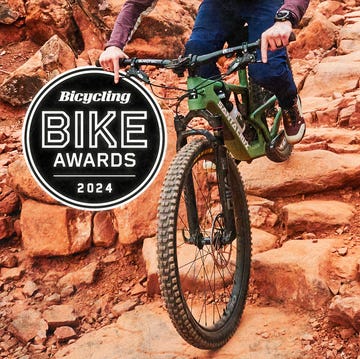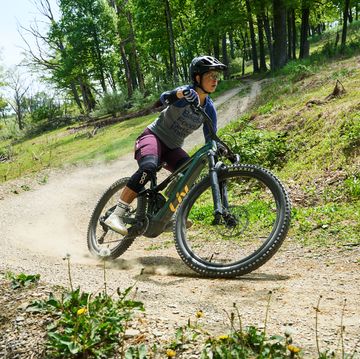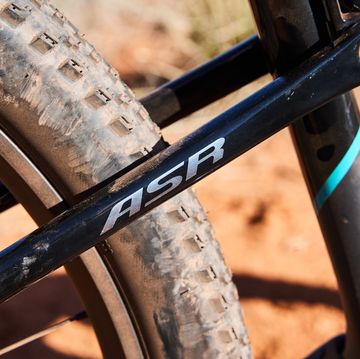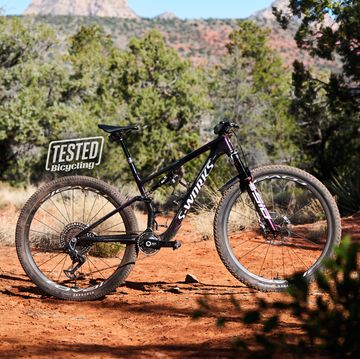The design made Cane Creek’s Double Barrel shocks the most tunable on the market. But the coil and air versions required a piggyback reservoir, which made them too large and too heavy for most trail bikes. With the Inline, Cane Creek offers much of the performance and adjustability of the Double Barrel in a more svelte package: It weighs 200 to 250 grams less than the DBAir CS—that’s only about 100 grams more than the popular Fox Float shock. Cane Creek says the Inline is made for bikes with 120mm to 150mm of travel and will be available on the Ibis Ripley, Norco Sight, and Specialized Enduro, among others.
The Inline has four screws that users can adjust with a hex wrench to change the shock’s high- and low-speed compression as well as its high- and low-speed rebound. Each function can be set independent of the others—that’s what gives riders so much control over the shock’s performance. The Inline also has a lever, called the Climb Switch (CS), that stiffens the bike’s low-speed compression and rebound settings for more efficient performance when you’re hammering on the pedals.
Cane Creek also designed the Inline to perform consistently throughout its entire stroke, especially under hard use. To do so, it limits the quantity of air bubbles that can form in the oil damper as the piston slides through it, a process called cavitation that can cause the shock to fade. A secondary chamber contains hard-to-compress nitrogen, which helps balance the pressure above and below the piston—a key in preventing the formation of air bubbles. Cane Creek also designed the Inline to better shed heat, which further reduces the chance of cavitating. So not only does the shock feel consistent from the top of the stroke all the way to the bottom, it also feels consistent at each point of its stroke.
In addition to the four rebound and compression settings, users can insert easy-to-install rubber spacers into the air chamber to change the shock’s spring curve. Adding spacers causes the shock’s travel to ramp up quicker and feel firmer at the bottom of the stroke. You can also spin the air valve to position it in a location that’s most convenient for you.
I rode this shock on two bikes—the Bianchi Methanol and the Norco Sight—and was highly impressed. Though the Methanol 29 had only 100mm of travel, the shock made that small amount of travel capable of handling near-vertical stepped descents. I didn’t ride the Methanol with another shock so I can’t say with certainty how much credit the Inline deserves, but I ripped through terrain I wouldn’t usually have felt confident tackling on a bike with so little suspension. With the Climb Switch on, the bike scampered up gravelly climbs, but I found it stiff enough to limit traction. However, you can position the switch between on and off, which directs some oil through the climb circuit and some through the user-selected adjusters. That gave the bike more traction on uphill roots without making it bouncy.
Each bike comes with a preset climb setting, but you can have a Cane Creek service center permanently change the “on” climb setting—it’s not a complicated procedure, but it does require a special tool.
After several runs on the Bianchi, I jumped on Norco’s 140mm-travel Sight. The bike smoothed the edges of sharp rocks and felt buttery across loose gravel and roots. The shock had excellent medium-bump compliance and allowed the bike to whip around wall-ride-type berms without wallowing. I blasted through loose corners, little airs, mud, rocks, and roots at speeds much faster than I am normally comfortable with.
With so much control at your fingertips, you could inadvertently misadjust the shock or simply become overwhelmed by the tuning options. While each Inline will come with a preset tune that is ideal for most conditions, Cane Creek also supplies a tuning guide to walk you through the process. It also developing an interactive app that it hopes to have ready this fall.
Models with the DBInline should become available early this summer. The shock hits the market June 1 and will cost $495.
We sampled Cane Creek’s new DBInline shock on the rocky, wet trails near Asheville, North Carolina. (Derek DiLuzio)
Smaller than the DBAir, the Inline is intended for bikes with 4 to 6 inches of travel, like Specialized’s Enduro. (Derek DiLuzio)
In addition to independent circuits for high- and low-speed compression and rebound, the Inline’s Climb Switch automatically selects the ideal setting for ascents. (Derek DiLuzio)














